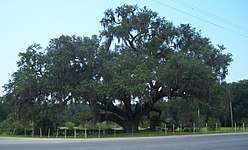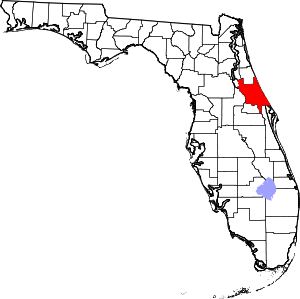Volusia, Florida
Volusia (/vəˈluːʃə/, və-LOOSH-ə) is an unincorporated community in Volusia County, Florida, United States on the eastern shore of the St. Johns River, about three miles south of Lake George and across the river from the town of Astor in Lake County. Volusia is one of the oldest European settlements in Florida.[5] The main route through the town is State Road 40, which crosses the St. Johns on the Astor Bridge.
Volusia Maiaca[1] Volusia Landing | |
|---|---|
 Historic oak near the St. Johns River | |
| Nickname(s): "Town of Many Forts"[1] | |
 Volusia | |
| Coordinates: 29°10′07″N 081°31′15″W | |
| Country | |
| State | |
| County | Volusia |
| Settled | Before 1558 |
| Area | |
| • Total | 1.8 sq mi (5 km2) |
| Elevation | 16 ft (5 m) |
| Population | |
| • Total | 596 (estimate) |
| Demonym(s) | Volusian |
| Time zone | UTC-5 (Eastern (EST)) |
| • Summer (DST) | UTC-4 (EDT) |
| ZIP code | 32102 |
| Area code(s) | 352 |
| GNIS feature ID | 306545[4] |

Volusia County takes its name from the community of Volusia, which was named such by at least as early as 1815. The site of Volusia was an established native settlement by 1558 when its indigenous inhabitants, the Mayaca, were first encountered by Spanish explorers. Since then, it has been the location of several forts, trading posts and a port on the St. Johns River, as well as the site of conflicts with the Seminole people during Florida's tumultuous beginnings.[1]
History
Pre-European
The indigenous Mayaca people inhabited much of the area now known as Volusia County along the St. Johns river. A settlement just south of Lake George known as Maiaca (or Mayaca) was likely the largest of the Mayaca villages.[6] Historical sources frequently refer to the native Timucua as having inhabited large areas of Florida including areas along the St. Johns river. However, other sources posit that the Mayaca were a distinct group of people with their own language, customs and settlements. Alliances were formed between smaller native groups. The village of Mayaca (Mayarca) was identified as belonging to the Outina confederation at one point, and with the Saltwater Timucua at another.[7]
According to Franciscan missionary Francisco de Ayeta in his 1691 deposition, the Mayaca lived south of Freshwater Timucua territory, and were described as "being so wild a nation and of no sense at all, who in no way want to make a village, nor even plant for their substenance, nor ever live in a determined place."
Spanish period (1566-1763)

The first European mention of present day Volusia was by Hernando de Escalante Fontaneda, who in memoirs covering the period of 1558-1575, mentions Mayaca.[1]
In 1566, Pedro Menéndez de Avilés made a voyage up the St. Johns river to meet with principle caciques (chiefs). He encountered the village of a cacique known as Macoya, believed to be the Mayaca mission of the early 17th century, and thus Volusia. After venturing a little farther up river, Menéndez was threatened with war by Macoya if he did not turn back.
By about 1602, Mayaca had a mission church and reportedly 100 natives who had not yet been baptized. The general consensus at the time was that the Mayaca were a distinct people from the (Sweetwater) Timucua, although the occupied part of the territory traditionally identified as Timucuan.[7]
The mission of San Salvador de Mayaca appeared on a list of missions in 1655.[7] In 1657, the site of San Salvador de Mayaca was constructed in present-day Volusia on the existing shell mounds of the Mayaca people.[1] In about 1680, it was settled and became the second-oldest Spanish base in Florida after St. Augustine.[5]
A fort called Antonio de Anacape was built in 1680. Slabs of crude mortar were found on a small Indian mound about 500 yards from Volusia's Landing.[1]
In 1689, a list of Timucua-speaking missions includes the mission of San Antonio de Mayaca with 30 families, or approximate 150 people, although there is strong evidence that Mayaca's inhabitants did not speak the Timucua language.
A 1717 census conducted by the Spanish refers to the native village of San Joseph de Jororo (Maiaca Language) and enumerates 33 natives.[7]
By the mid-18th century, the Mayaca had been all but wiped out by invading native tribes from the north, including the Yamassee and the Euchees.[1]
British period (1763-1783)
In 1763, James Spaulding and Roger Kelsall partnered to open five stores in Florida, including one in Volusia known as Spaulding's "Upper Store." The store is believed to have existed on the west bank of the St. Johns river near Volusia from between at least 1765 and 1787.
Second Spanish period (1783-1819)
After the U.S revolutionary war, the British transferred Florida back to Spain in the Treaty of Versailles. James Spaulding's Upper and Lower stores were allowed to continue operating.
The Spaulding's Upper store later came under the ownership of Panton, Leslie & Company and was known as Panton, Leslie Trading House. It existed on the east bank at Volusia from 1787 until at least 1834.[1][6]
The first known use of Volusia as a geographic place name occurs 1815, and is revealed in a series of Spanish Land Grants and Confirmed Claims as follows:
Amiens 15, Octobre In November 1817, the Spanish Government agreed to my claim for land in Velutia. James Alexander, my attorney, proceeded to St. Augustine to carry these transactions into effect; he was occupied with the voyage and these transactions when cession of the Floridas was ratified 19th February 1819. Meanwhile U.S. settlements have been commenced. Mitchell, Alexander and Dexter have interveined(sic) in my behalf to explain my delay.
Signed Joseph RattenburyAmerican period (1819-Present)
.png)
By 1822, Volusia is described by William Hayne Simmons in his Notices of East Florida as "...a very fine tract, lying on both sides of the St John's (sic) - the greater portion being on the western side of the river." The author goes on to say that the settlement was made nearly three years ago by Horatio S. Dexter, its present proprietor.[8]
Volusia County was named after the then-largest community, Volusia, when the Florida legislature divided Orange County on December 29, 1854. At the time, Volusia County had as few as 600 residents.[9]
Etymology
The origin of the name Volusia remains uncertain as there exists no documentation establishing the etymology. There are several theories:
- The name came from a word meaning "Land of the Euchee," from the Euchee indians who migrated into the area after the Timucua Indian cultures faded away in the early 18th century.[9] The Euchees (or Uchees) occupied the area between Spring Garden and the southern tip of Lake George. Records prior to 1815 referred to this area as Euchee territory. The name Volusia was spelled as Velutia by the French and Volucia by the Spanish.[1]
- The name was taken from the a British man named Voluz who owned a plantation located on the St. Johns River in the late 18th century.[10]
- The name originated from the last name Veluche belonging to the French or Belgian owner of the trading post in Volusia. According to some, this was during the British regime, and according to others, it was around 1818. Over time, the name Veluche became anglicized to Volusia.[11]
- The town was established by and named for Jere Volusia.[12]
- The settlement was named by the Spanish after the celebrated Roman jurist Volusio, who wrote 30 books and tutored Marcus Aurelius, the Roman emperor and philosopher.[10]
Notes
- Near the location of The Yearling, a 1938 book by Marjorie Kinnan Rawlings and mentioned in the story.
References
- Gibson, Lillian Dillard (1978). Annals of Volusia, 1558-1978: birthplace of Volusia County. Volusia, Florida: R. Alex Gibson.
- Google Earth Polygon Calculation
- "2010 Census Interactive Population Map". US Census Bureau. Archived from the original on October 13, 2013. Retrieved 24 August 2011.
- "US Board on Geographic Names". United States Geological Survey. 2007-10-25. Retrieved 2008-01-31.
- Robinson, Jim (8 June 1997). "Spanish Missionaries Find Tribes Devoted To Centuries-old Cultures". The Orlando Sentinel.
- Franke, Arthur E. (1986). Volusia the West Side. DeLand, FL: West Volusia Historical Society. pp. 2–6.
- Hann, John H. (1996). The History of the Timucua Indians and Missions. Gainesville, FL: University Press of Florida. ISBN 0-8130-1424-7.
- Simmons, William Hayne (1822). Notices of East Florida. Gainesville, FL: University of Florida Press (1973 reprint). pp. 27, 28, 59. ISBN 0-8130-0400-4. Retrieved 18 August 2011.
- Scofield, Tom. "What's in a name? Origins of Volusia". Volusia County. Archived from the original on 5 August 2011. Retrieved 17 August 2011. According to Pleasant Daniel Gold, in his 1927 book History of Volusia County Florida, there were fewer than 30 families living in Volusia County when it was formed.
- Poertner, Bo (10 May 1997). "While Visiting France, Volusia Man Finds Possible Link To County's Name". Orlando Sentinel. Retrieved 18 August 2011.
- Gold, Pleasant Daniel (1927). History of Volusia County Florida. Daytona Beach, FL: Higginson Book Company (reprint). pp. 78–84. ISBN 0-8328-7061-7.
- The Journal of American History. 11 (1): 68. January–March 1917. Missing or empty
|title=(help)
